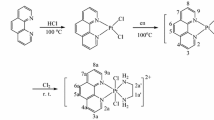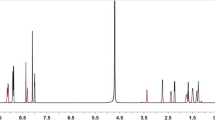Abstract
Glutathione (GSH) reduction of the anticancer-active platinum(IV) compounds trans-[PtCl4(NH3)(thiazole)] (1), trans-[PtCl4(cha)(NH3)] (2), cis-[PtCl4(cha)(NH3)] (3) (cha=cyclohexylamine), and cis-[PtCl4(NH3)2] (4) has been investigated at 25 °C in a 1.0 M aqueous medium at pH 2.0–5.0 (1) and 4.5–6.8 (2–4) using stopped-flow spectrophotometry. The redox reactions follow the second-order rate law d[Pt(IV)]/dt=k[GSH] tot[Pt(IV)], where k is a pH-dependent rate constant and [GSH] tot the total concentration of glutathione. The reduction takes place via parallel reactions between the platinum(IV) complexes and the various protolytic species of glutathione. The pH dependence of the redox kinetics is ascribed to displacement of these protolytic equilibria. The thiolate species GS− is the major reductant under the reaction conditions used. The second-order rate constants for reduction of compounds 1–4 by GS− are (1.43±0.01)×107, (3.86±0.03)×106, (1.83±0.01)×106, and (1.18±0.01)×106 M−1 s−1, respectively. Rate constants for reduction of 1 by the protonated species GSH are more than five orders of magnitude smaller. The mechanism for the reductive elimination reactions of the Pt(IV) compounds is proposed to involve an attack by glutathione on one of the mutually trans coordinated chloride ligands, leading to two-electron transfer via a chloride-bridged activated complex. The kinetics results together with literature data indicate that platinum(IV) complexes with a trans Cl-Pt-Cl axis are reduced rapidly by glutathione as well as by ascorbate. In agreement with this observation, cytotoxicity profiles for such complexes are very similar to those for the corresponding platinum(II) product complexes. The rapid reduction within 1 s of the platinum(IV) compounds with a trans Cl-Pt-Cl axis to their platinum(II) analogs does not seem to support the strategy of using kinetic inertness as a parameter to increase anticancer activity, at least for this class of compounds.
Similar content being viewed by others
Abbreviations
- cha:
-
cyclohexylamine
- dach:
-
±trans-1,2-diaminocyclohexane
- GSH:
-
glutathione
- RSH:
-
thiol
- Tz:
-
thiazole
References
Rosenberg B, VanCamp L, Trosko JE, Mansour VH (1969) Nature 222:385–386
Wong E, Giandomenico CM (1999) Chem Rev 99:2451–2466
Reedijk J (1999) Chem Rev 99:2499–2510
Gelasco A, Lippard SJ (1999) In: Clarke MJ, Sadler PJ (eds) Topics in biological inorganic chemistry, vol 1. Springer, Berlin Heidelberg New York, pp 73–98
Bramwell VHC, Crowther D, O’Malley S, Swindell R, Johnson R, Cooper EH, Thatcher N, Howell A (1985) Cancer Treat Rep 69:409–416
Pendyala L, Cowens JW, Chedda GB, Dutta SP, Creaven PJ (1988) Cancer Res 48:3533–3536
Rahman A, Roh JK, Wolpert-DeFilippes MK, Goldin A, Venditti JM, Woolley PV (1988) Cancer Res 48:1745–1752
Giandomenico CM, Abrams MJ, Murrer BA, Vollano JF, Rheinheimer MI, Wyer SB, Bossard GE, Higgs III JD (1995) Inorg Chem 34:1015–1021
Barnard CFJ, Raynaud FI, Kelland LR (1999) In: Clarke MJ, Sadler PJ (eds) Topics in biological inorganic chemistry, vol 1. Springer, Berlin Heidelberg New York, pp 45–71
Ferrante K, Winograd B, Canetta R (1999) Cancer Chemother Pharmacol 43:S61–68
Farrell N (1996) In: Sigel A, Sigel H (eds) Metal ions in biological systems, vol 32. Dekker, New York, pp 603–639
Natile G, Coluccia M (1999) In: Clarke MJ, Sadler PJ (eds) Topics in biological inorganic chemistry, vol 1. Springer, Berlin Heidelberg New York, pp 45–71
Van Beusichem M, Farrell N (1992) Inorg Chem 31:634–639
Kelland LR, Barnard CFJ, Evans IG, Murrer BA, Theobald BRC, Wyer SB, Goddard PM, Jones M, Valenti M, Bryant A, Rogers PM, Harrap KR (1995) J Med Chem 38:3016–3024
Bierbach U, Qu Y, Hambley TW, Peroutka J, Nguyen HL, Doedee M, Farrell N (1999) Inorg Chem 38:3535–3542
Roat R, Reedijk J (1993) J Inorg Biochem 52:263–274
Roat R, Jerardi MJ, Kopai CB, Heath DC, Clark JA, DeMars JA, Weaver JM, Bezemer E, Reedijk J (1997) J Chem Soc Dalton Trans 3615–3621
Rotondo E, Fimiani V, Cavallaro A, Ainis T (1983) Tumori 69:31–36
Blatter EE, Vollano JF, Krishnan BS, Dabrowiak JC (1984) Biochemistry 23:4817–4820
Eastman A (1987) Biochem Pharmacol 36:4177–4178
Pendyala L, Arakali AV, Sansone P, Cowens JW, Creaven PJ (1990) Cancer Chemother Pharmacol 27:248–250
Talman EG, Brüning W, Reedijk J, Spek AL, Veldman N (1997) Inorg Chem 36:854–861
Shi T, Berglund J, Elding LI (1996) Inorg Chem 35:3498–3503
Shi T, Berglund J, Elding LI (1997) J Chem Soc Dalton Trans 2073–2077
Lemma K, Shi T, Elding LI (2000) Inorg Chem 39: (in press)
Chen L, Lee PF, Ranford JD, Vittal JJ, Wong SY (1999) J Chem Soc Dalton Trans 1209–1212
Choi S, Filotto C, Bisanzo M, Delaney S, Lagasee D, Witworth JL, Jusko A, Li C, Wood NA, Willingham J, Schwenker A, Spaulding K (1998) Inorg Chem 37:2500–2504
Lemma K, Sargeson AM, Elding LI (2000) J Chem Soc Dalton Trans 1167–1172
Pendyala L, Krishnan BS, Walsh JR, Arakali AV, Cowens JW, Creaven PJ (1988) Cancer Chemother Pharmacol 25:10–14
Chaney SG, Wyrick S, Till GK (1990) Cancer Res 50:4539–4545
Ellis LT, Er HM, Hambley TW (1995) Aust J Chem 48:793–806
Lempers ELM, Inagaki K, Reedijk J (1988) Inorg Chim Acta 152:201–207
Bancroft DP, Lepre CA, Lippard SJ (1990) J Am Chem Soc 112:6860–6870
Eastman A, Barry MA (1987) Biochemistry 26:3303–3307
Taylor JE, Yan JF, Wang JI (1966) J Am Chem Soc 88:1663–1667
Bridgart GJ, Wilson IR (1973) J Chem Soc Dalton Trans 1281–1284
Ehrenberg L, Harms-Ringdahl M, Fedorcak I, Granath F (1989) Acta Chem Scand 43:177–187
Appleton TG, Connor JW, Hall JR, Prenzler PD (1989) Inorg Chem 28:2030–2037
Berners-Price SJ, Kuchel PW (1990) J Inorg Biochem 38:305–326
Djuran MI, Lempers ELM, Reedijk J (1991) Inorg Chem 30:2648–2652
Rabenstein DL (1973) J Am Chem Soc 95:2797–2803
Mason WR (1972) Coord Chem Rev 7:241–255
Wilmarth WK, Fanchiang Y-T, Byrd JE (1983) Coord Chem Rev 51:141–153
Chandayot P, Fanchiang Y-T (1985) Inorg Chem 24:3532–3534
Chandayot P, Fanchiang Y-T (1985) Inorg Chem 24:3535–3537
Peloso A, Dolcetti G, Ettorre R (1967) Inorg Chim Acta 1:403–406
Peloso A, Ettorre R, Dolcetti G (1967) Inorg Chim Acta 1:307–310
Elding LI, Gustafson L (1976) Inorg Chim Acta 19:165–171
Elding LI, Gustafson L (1977) Inorg Chim Acta 24:239–246
Drougge L, Elding LI (1986) Inorg Chim Acta 121:175–183
Berglund J, Voigt R, Fronaeus S, Elding LI (1994) Inorg Chem 33:3346–3353
Shi T, Elding LI (1998) Inorg Chim Acta 282:55–60
Wilmarth WK, Dooley MM, Byrd JE (1983) Coord Chem Rev 51:125–139
Allison WS (1976) Acc Chem Res 9:293–299
Szajewski RP, Whitesides GM (1980) J Am Chem Soc 102:2011–2026
Farrell N, Kelland LR, Roberts JD, van Beusichem M (1992) Cancer Res 52:5065–5072
Gibbons GR, Wyrick S, Chaney SG (1989) Cancer Res 49:1402–1407
Evans DJ, Green M (1987) Inorg Chim Acta 130:183–184
Author information
Authors and Affiliations
Corresponding author
Additional information
Supplementary material. Tables S1-S7 are available in electronic form on Springer-Verlag’s server at http://link.springer.de/journals/jbic/
Rights and permissions
About this article
Cite this article
Lemma, K., Berglund, J., Farrell, N. et al. Kinetics and mechanism for reduction of anticancer-active tetrachloroam(m)ine platinum(IV) compounds by glutathione. JBIC 5, 300–306 (2000). https://doi.org/10.1007/PL00010658
Received:
Accepted:
Published:
Issue Date:
DOI: https://doi.org/10.1007/PL00010658




